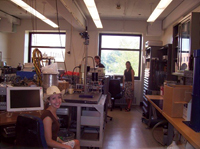Preparing for a Martian landing

Students at The College of New Jersey are not solely involved in researching and contributing to the community — they’re doing so for the solar system, as well.

Justin Nieusma's workspace at Goddard.
Students at The College of New Jersey are not solely involved in researching and contributing to the community — they’re doing so for the solar system, as well.
Since last semester, students at TCNJ have been collaborating with NASA on a project to investigate methane gas on Mars and the diffusion of this gas. Last year, John Gannon ’07 and Justin Nieusma ’09, a physics and mathematics double major, were supervised by Thulsi Wickramasinghe, associate professor of physics. The three had the opportunity to work with Michael Mumma, director of the Institute for Astrobiology at NASA ’s Goddard Space Flight Center (NGSFC), and Geronimo Villanueva, a main associate of Mumma ’s, at the NGSFC in Virginia.

For the project, the students “were to learn as much about [methane gas on Mars] as possible and then design and create a program that would simulate the diffusion of methane from a surface vent on Mars into the atmosphere, taking into account the variety of planetary and atmospheric conditions, ” Nieusma said. The project should be useful in locating vents on Mars to prepare for possible landing sites on future trips to the planet.
Nieusma is the only student still working on the project, since Gannon’s graduation in May. As one of nine interns in the 10-week Summer Undergraduate Internship in Astrobiology, Nieusma worked directly with Villaveuva.
Upon his return, Nieusma was pleased about his time at NGSFC. “It was really a positive experience in many ways,” he said. Nieusma also studied carbon dioxide in the atmosphere at different latitudes and “thus determined the air pressure at
the surface as it changed with latitude.” His research will be included in an atlas of the Martian spectrum that is being compiled by the institute.
Although Nieusma enjoyed his research, “There was perhaps even more importance in the other summer accomplishments and experiences. ” Most notably, he and his peers had their research presentations broadcast via the Internet to different Web sites, including the National Astrobiology Institute and Cornell University. The students were also allotted a two-minute question-and-answer session with the Web sites ’ audiences.
Posted on April 28, 2008

